Welcoming quilting enthusiasts from around the state and across the country, PBS Wisconsin and Nancy Zieman Productions will host the 19th annual Great Wisconsin Quilt Show Sept. 7-9, 2023 at the Alliant Energy Center in Madison.
One of the exhibits featured this year, “Quilted Education presents: A Celebration of Black History by Karen Hinton Robinson” all started with a touching story about a mother finding a creative solution to a problem.
When Karen Hinton Robinson’s daughter, Kayla was in fourth grade, her teacher told her he didn’t have time to teach Black history in class. This upset both Kayla and Karen. In response, Karen made a quilt about historical Black people who made significant achievements and presented it the following year to Kayla’s fifth grade class. This was just the beginning of many presentations of this quilt and many historical quilts that Karen would later create.
PBS Wisconsin spoke with Karen Hinton Robinson about the quilts that will be displayed at the 2023 Great Wisconsin Quilt Show and her journey from sewing to quilting, including inspiration from PBS Wisconsin’s Sewing With Nancy.
PBS Wisconsin: Tell us about yourself. Where are you from?
Robinson: I’m originally from North Carolina. My father was in the military, and retired in North Carolina, and I went to college at East Carolina University in North Carolina, and once I got my nursing certification I joined the Air Force and that took me to San Antonio, Texas and that’s where I stayed.
PBS Wisconsin: What did you do in the Air Force?
I was a nurse. I took care of critical care and eventually the outpatient clinic.
PBS Wisconsin: And you did that while you were raising a family?
Robinson: Of course! My husband and I had two kids, Kayla and Kendall. And I’m a member of Delta Sigma Theta Incorporated, which is the sorority I joined in college, and we do a lot of community service as graduates and I’m still active with them.
And I retired from nursing full-time and became a full-time caregiver for my husband, who had severe illnesses the last 10 years until he passed away in January. But I continue nursing, I’m a functional nutrition coach, so I teach about healthy eating and overall wellness.
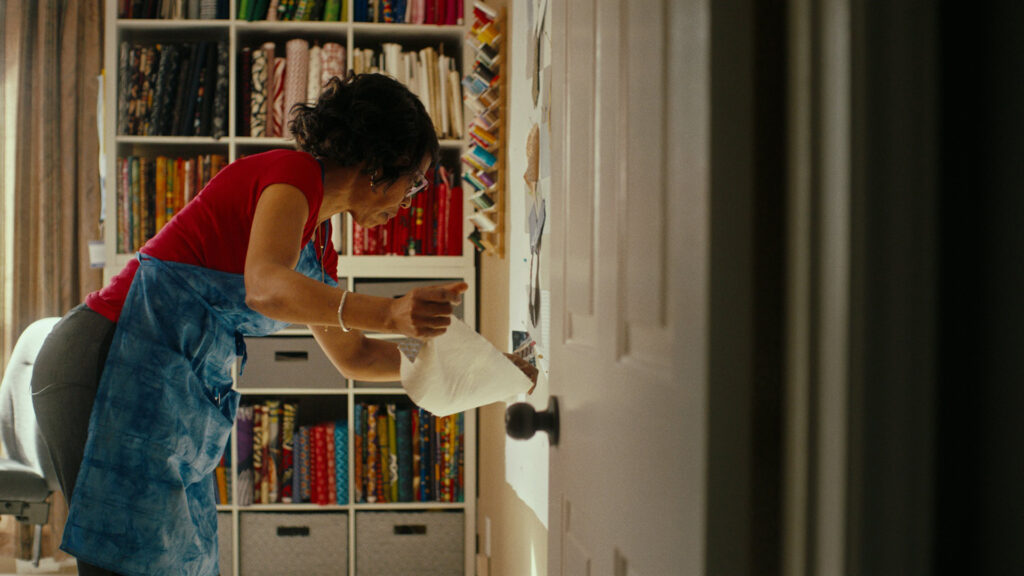
A still from “Quilted Education” by Kayla Robinson.
PBS Wisconsin: You learned to sew from your mother, but it was your 7th grade home economics class where you learned the more technical skills. Can you talk about what clicked for you?
Robinson: My mother liked to sew, but she wasn’t necessarily neat or it didn’t always look that good, and I was a critic even though I didn’t know what I was doing. But I seem to be drawn to structure, and the structured sewing lessons just clicked with me. Then when I won the Future Homemakers of America award, my gift was a sewing class with adults. To me that was just the ultimate because I was about 15 years old, and I was in a class with women in their 30s — who seemed so much older than me! — but the instructor treated me like an adult.
The instructor was very kind to me, but I remember her not giving me a break. That way, I learned things that would stick with me, like when you get a pattern you iron it, you fold it, or as you’re working on a project you sew and then iron, or you sew, then press. And a lot of people don’t understand those rules, and that makes a difference in your garment and what it looks like.
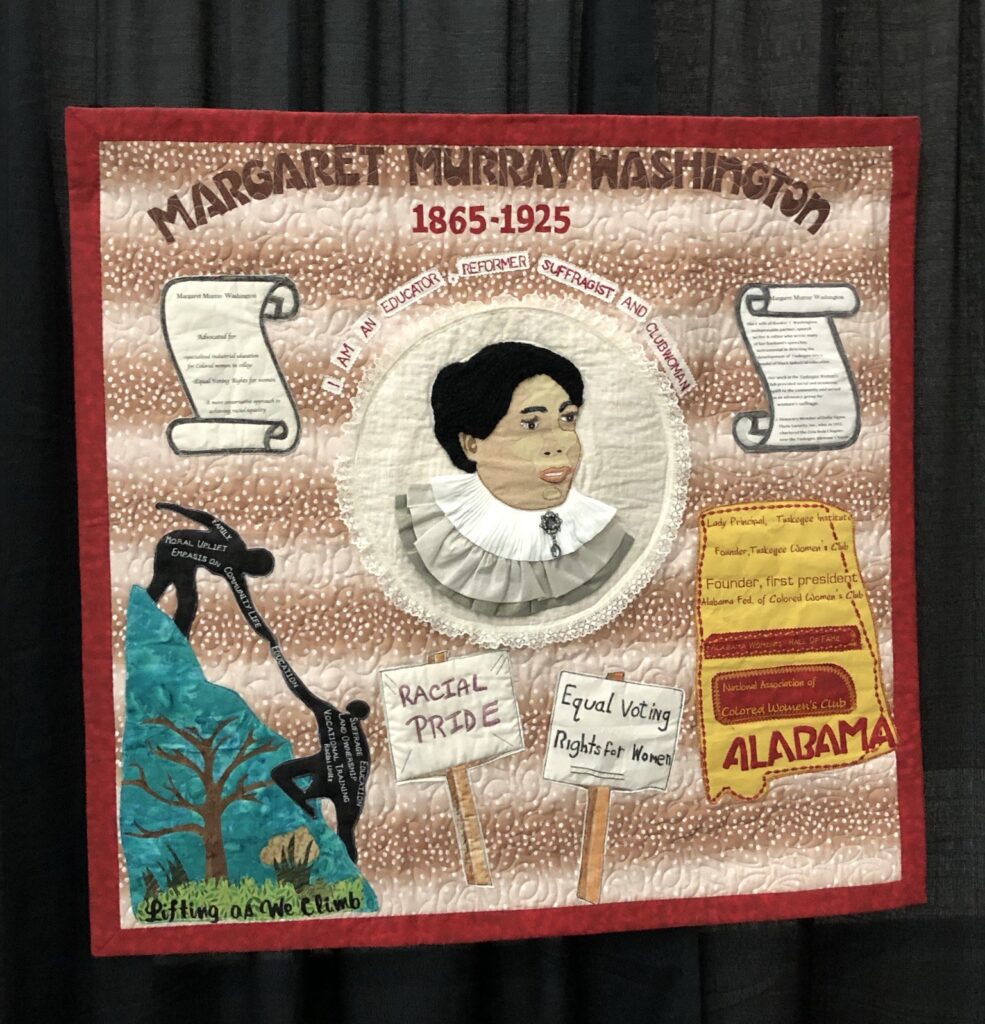
“Margaret Washington Quilt”
PBS Wisconsin: How did Sewing With Nancy impact your sewing journey and what did the show mean to you?
Robinson: Oh, my goodness! My daughter doesn’t know about Sewing With Nancy, and so when she was first approached by PBS Wisconsin about exhibiting my quilts, all those memories came flooding back to me, because before the Internet, before YouTube videos, there was Nancy.
Back when I used to make Kayla dresses, I remember watching Nancy demonstrating different techniques and interviewing different guests, and when her show was on, that was just my moment, you know? Don’t bother me right now.
And it was so surreal when I met with Nancy’s close friend, Deanna [Springer, who is still involved with The Great Wisconsin Quilt Show]. When Kayla asked me if I wanted to meet with Deanna, it was literally a moment in my life that I won’t forget because, who would have thought after all this time that even though Nancy passed away, I get to be a part of something that she was part of?
Deanna said that Nancy would have loved our meeting because she liked touching people. I told my daughter, “Now, if you bring me Oprah Winfrey, I’ll be ready to leave.”
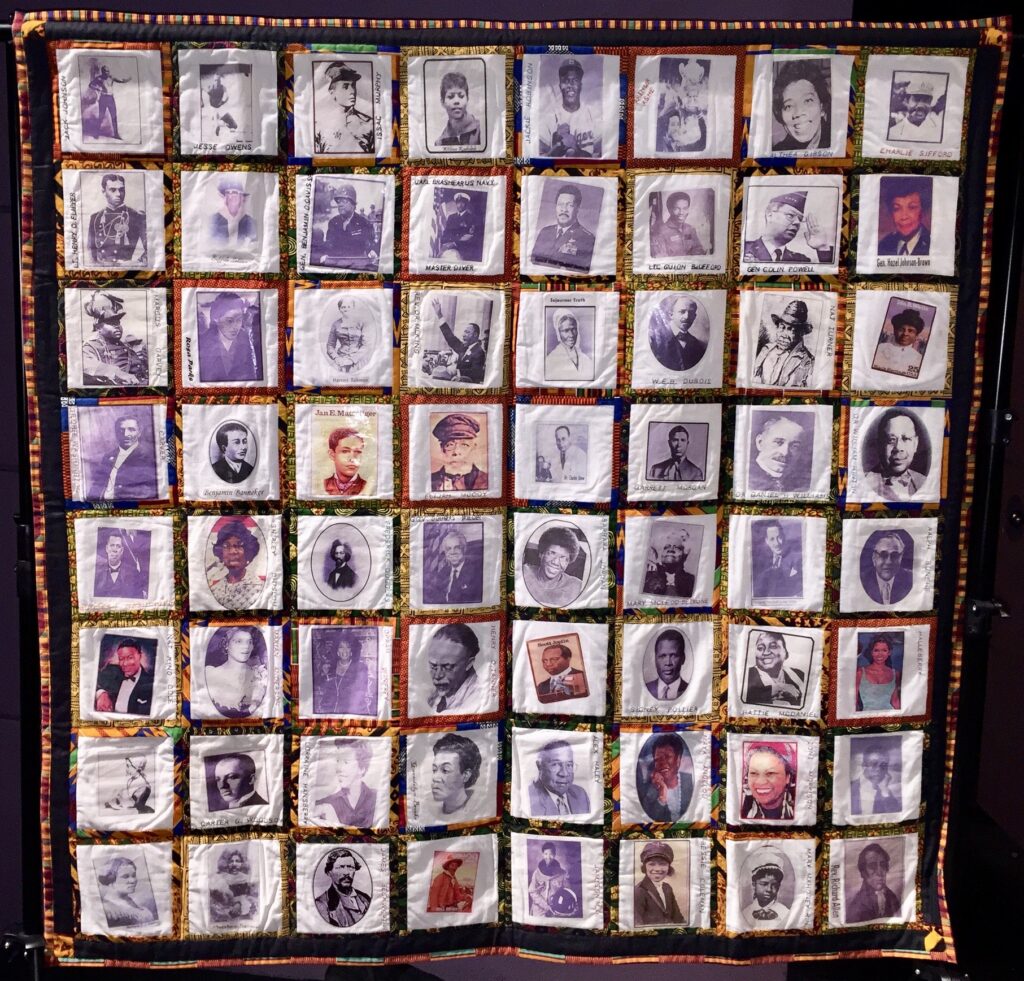
“Black History Quilt”
PBS Wisconsin: When you chose to transition from making clothes for your kids to making quilts, how did you find quilting?
Robinson: When I was in the Air Force going in the field and had free time when we weren’t working, I watched my lieutenant colonel make quilt squares that she was hand sewing appliqué. She was making a symbol that represented each one of her cousins, and that was going to be a quilt they gave her grandmother. As I watched her make those squares I thought, “That is just amazing!”
PBS Wisconsin: Tell us about some of your quilts that will be exhibited at The Great Wisconsin Quilt Show.
Robinson: The first quilt is the one I made after the incident with Kayla’s fourth grade teacher not knowing how to teach Black history. It’s my first history quilt, and it features 64 people from different categories. I included people who were either not well known or not known at all, and who had accomplished something significant that I thought was worth people knowing about.
The “Black History Quilt” really spurred me on to always make my quilts interactive, including my African American military quilt. I titled it “A Celebration of the American Negro Soldier,” because it spans from the time that the military was segregated — the Revolutionary War to World War Two. It really struck me that I am a veteran and I didn’t know 90% of the history in this quilt before I made it, so it was something that I felt was important to share.
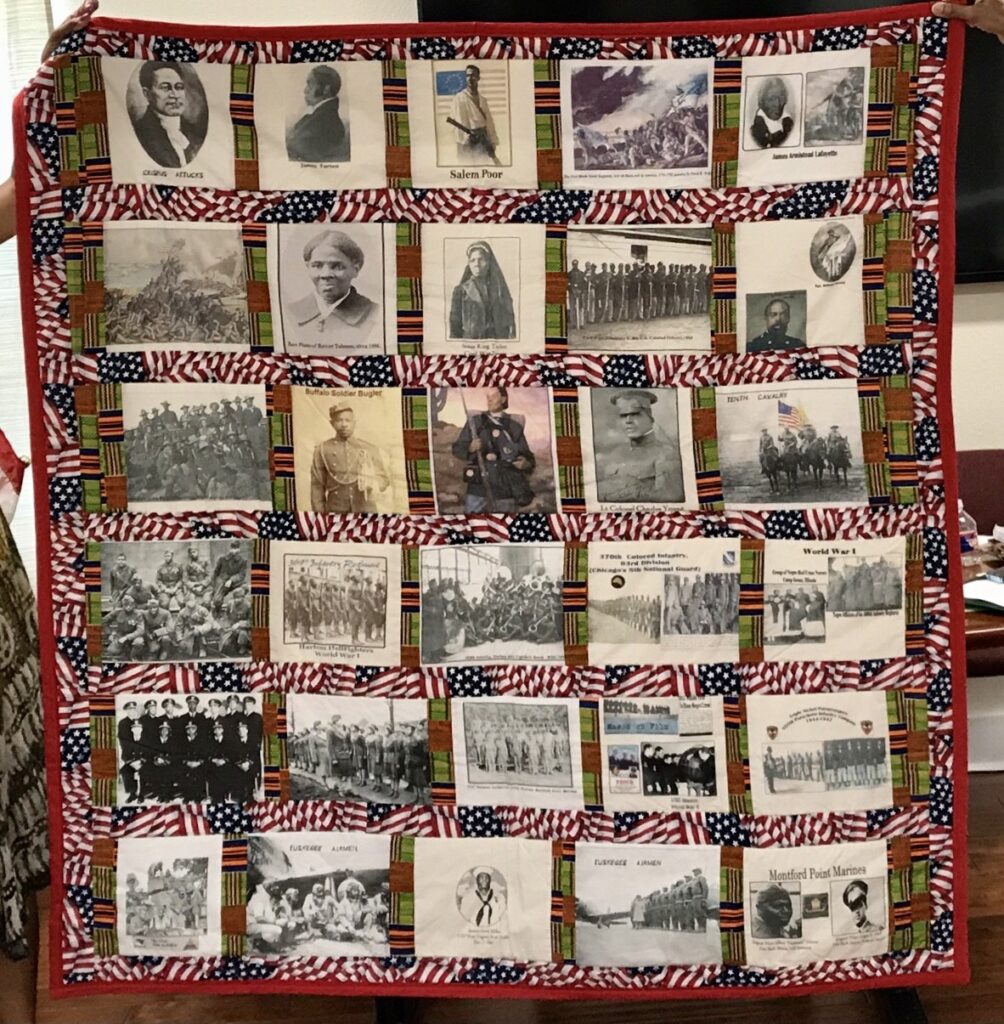
“A Celebration of Negro Soldiers”
There’s some men in my church who were part of the Buffalo Soldiers, and they went with me to different places to present the military quilt because they had skits and things that they could share. So that made it even more interactive, but I also made flash cards to talk about the people featured in the quilt.
Another quilt is about Nancy Green, AKA Aunt Jemima. Almost everybody knows Aunt Jemima, but a lot of people don’t know that Nancy Green was a real person, and in my mind, a great advertiser. She went from slavery to being a commercial model.
I made that quilt when Kayla was in college. She went to the University of Texas at Austin to major in physical therapy and then changed to advertising, and she thought I would be really upset. But you know your child is creative — you watch that. When Kayla was in the second grade she drew a picture of a squirrel that looked exactly like a squirrel. And so you kind of know that there’s talent there.
But I didn’t know anything about advertising. I knew doctor, lawyer — those kinds of jobs. The way I do things is I look for Black people or people of color in that field. And so when Aunt Jemima came up, I really wanted to tell that story.
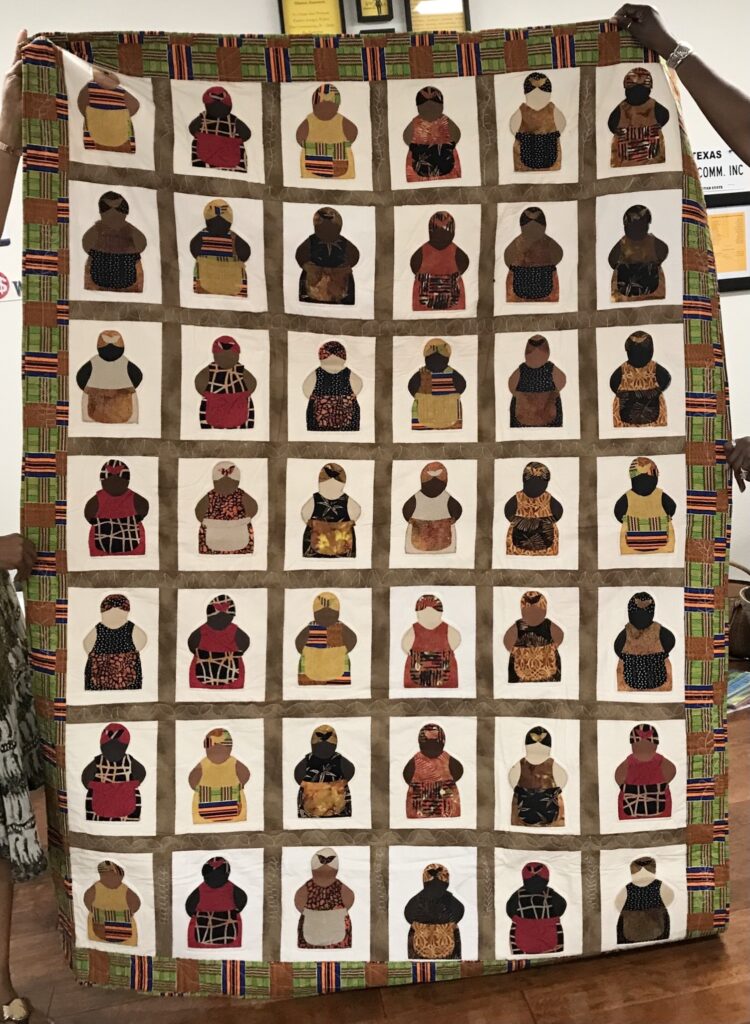
“Advertising Quilt featuring Nancy Green as Aunt Jemima”
And then I do military retirement quilts. I take folks and their story and all the different patches and badges ranks and different things that they did in their career and I create a quilt for them. Those are client quilts, but one of my friends let me use his quilt for this exhibit. It tells the story from when he was born, when he came into the military, and all the things that he wanted to share on his quilt so that he could leave it for his kids or his grandchildren.
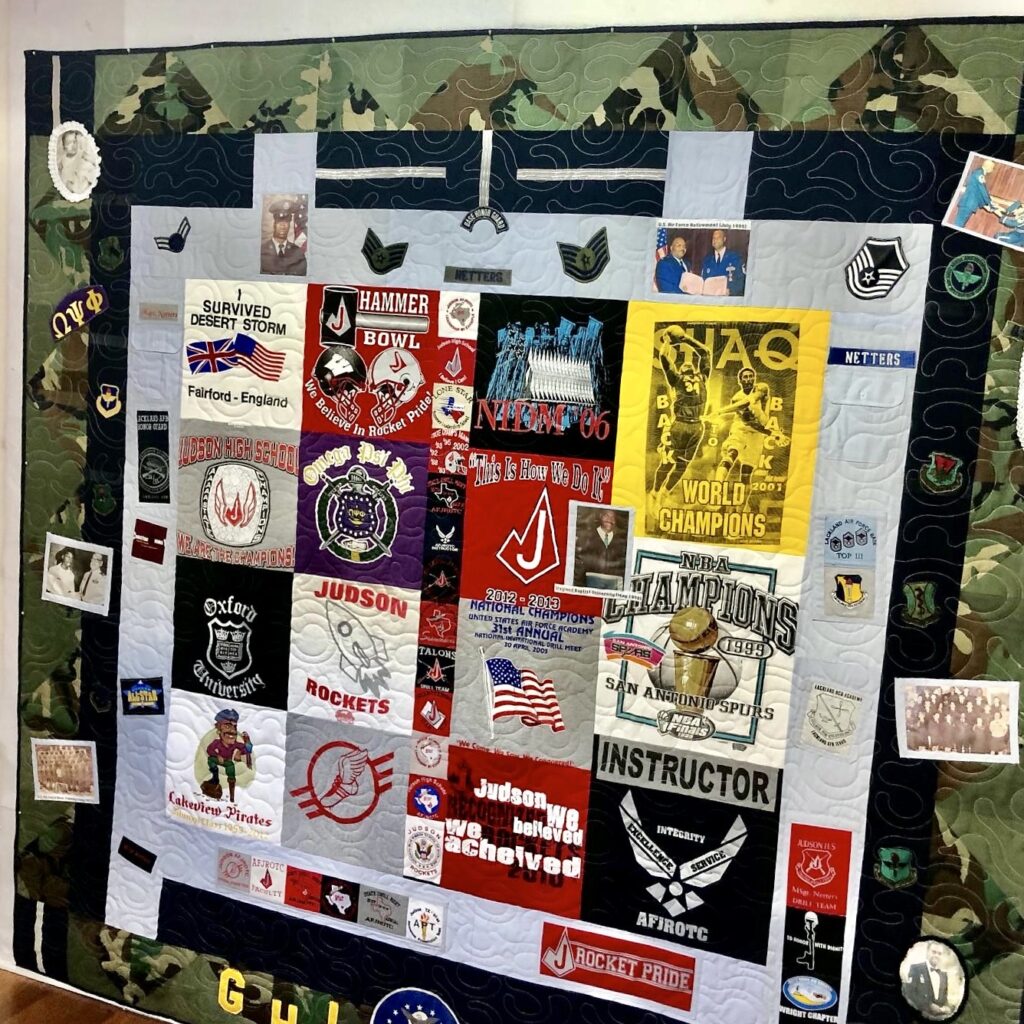
A military retirement quilt by Robinson
“Ellison’s Family History” quilt is about my family history. My mother’s family is unique. Someone in the family researched our history as far back as possible — it doesn’t go back to Africa, it only goes as far back as they can in America. We know that we’re from the King Plantation in Bladen County, North Carolina, so I took that history and made a quilt.
And we’re sort of a competitive family because our great-great grandparents had nine children, and we usually have representatives from each of those grandchildren at the family reunion. The competition is, we like to see how many family members are present from each line of descendants.
I highlighted everybody on the quilt that my direct line of descendants follows, starting with Harry, then my grandparents, my parents, myself and my children. But it still told a story. Grandmother Dolly helped deliver babies, and Grandpa Willis drove horse drawn stagecoaches, and they were people of God — and gosh darn, that was a quilt! We have it hanging up during reunions.
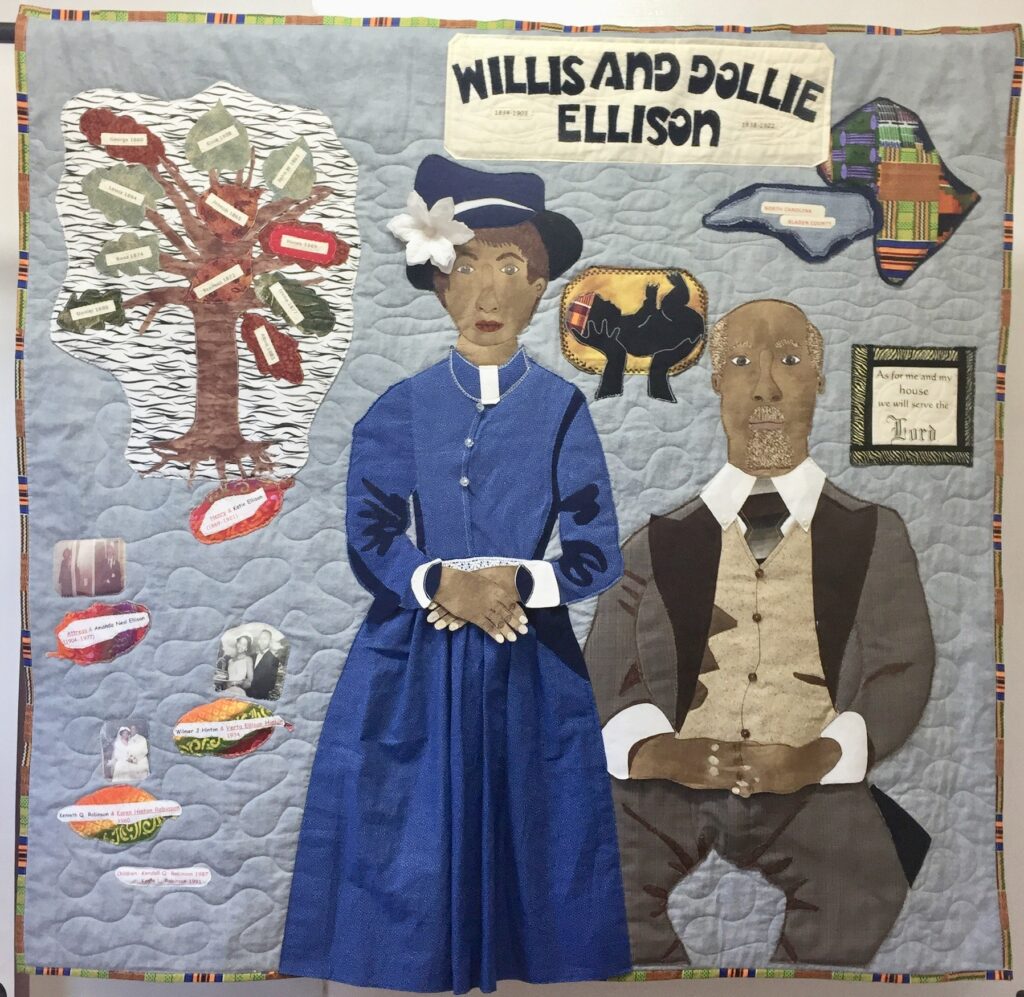
“Ellison’s Family History”
PBS Wisconsin: In the REEL SOUTH film as you’re being interviewed by your daughter, she says that for years you claimed you’re not a creative person. Can you talk about what creativity means to you?
Robinson: I like to create for other people, so to me creativity means taking something from other people and telling their story. So I like to ask people, “What is the most important memory that you want to display in this quilt?” And I just let them talk and I listen. Then I think about fabric or their items or a picture or a medal — in the case of the military — or jewelry and create something. It’s their words, but it’s my rendition of it.
I want to see them smile. I really want to see them cry, then I feel like I’m doing my job [laughs]. I can cry with you, but I want to see that tear. I’ll be honest, that’s what I’m after.
Featured image by Michael Meadows. Images of quilts courtesy of Karen Hinton Robinson.
 Passport
Passport











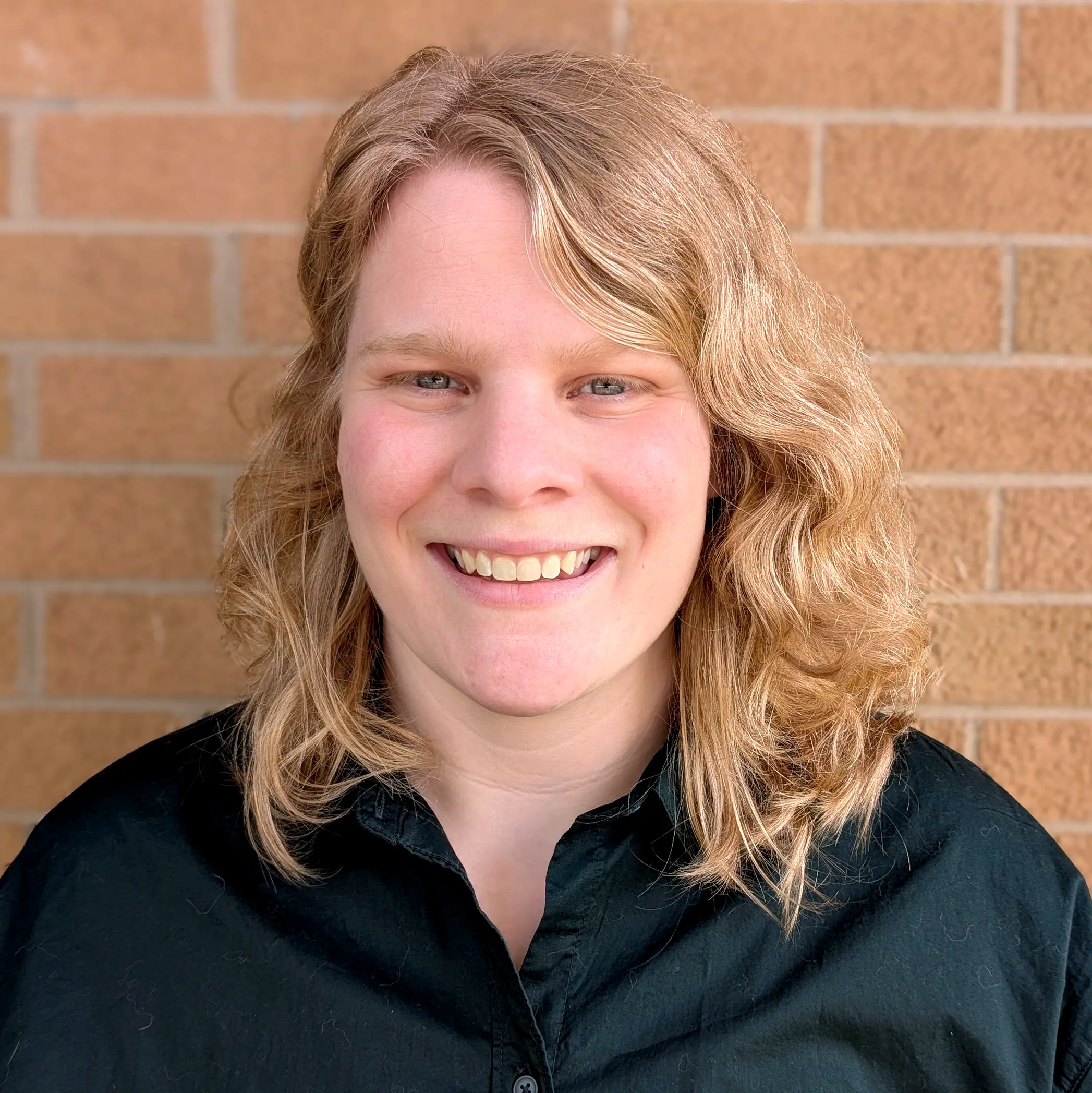

Carla J Seeks
Amazing. Thank you for sharing your story and your wonderful quilts.
Gladys
What a beautiful story and ministry!!
Barbara Blackmon-Gussak
What a beautiful way to remember your family history!! Thank you for sharing and inspiring!
Maxine Moore
Thank you so much for sharing this story that includes quilting and history
Jean
Wonderful, important, and beautiful!